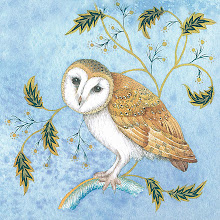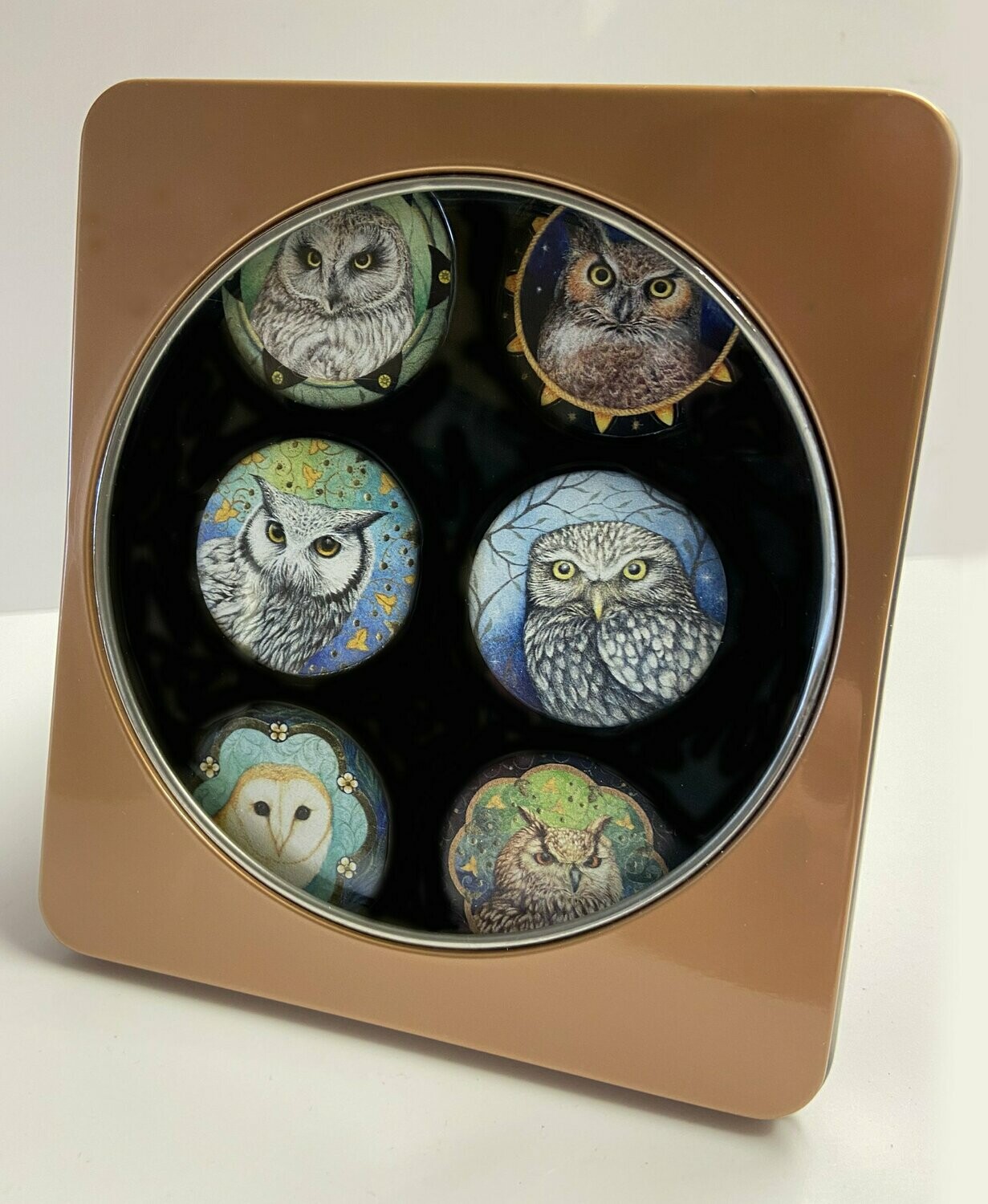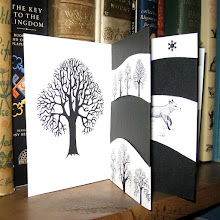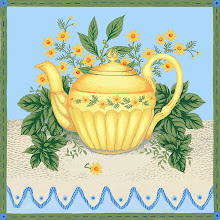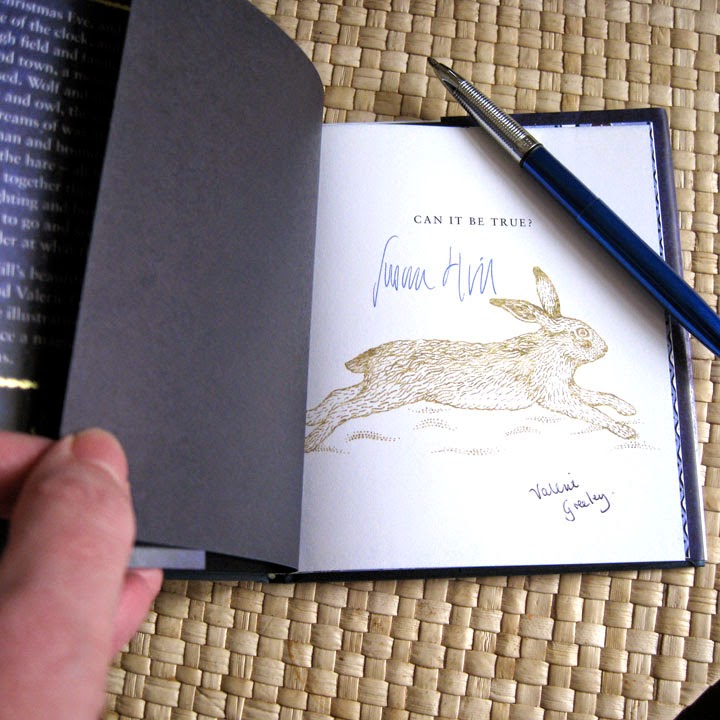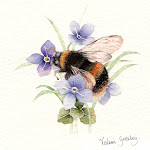
Celeste Goulding is an artist who works in a very decorative and detailed style, I was naturally drawn to her beautiful paintings and I know you are going to love them too so I decided to invite her round to a virtual tea party and of course that invitation is open to you too, so make yourself comfy and let the tea party commence.
How do you take your tea and in what kind of cup do you like it served?
I like my tea fairly strong with milk and 2 sugars. I grew up in a household where tea was served every day at 4pm sharp in a teapot with teacups and lace doilies, so I suppose that I developed a liking for delicate china quite early. These days, I generally use tea bags in a fine bone china mug. All my mugs are different. I buy them one at a time - whatever takes my fancy. One of my current favourites features ladies in Georgian dresses, which I bought in Bath at the Jane Austen museum shop. I'm fascinated by the Georgian period!
If you could choose anyone, past, present or future, who would be joining us for tea?
Beatrix Potter! I once visited the cottage where she lived in the Lakes District. It was wonderful! It was just like her illustrations - the garden, the staircase, the teacups, the windows, everything! She was a very inspiring woman. I can relate to way she went about creating her Art and the way she felt about her drawings. I would love to sit down with her and chat about one of her sketchbooks or maybe we could go out into her garden and sketch together. That would be lovely.

Tell me about you background in Art and Design.
I am the only person in my family who has pursued an artistic profession. I studied Art in high school during the 1970s and wanted to be an Artist, perhaps in Ceramics or Textiles, which were all the rage at that time but somehow I got into Banking and Finance and then I worked at my father's medical practice, so it was not until the age of 32 that I went to University to do a degree. The degree I chose was in Creative Arts which had students in various strands - Visual Arts and Design, Music Performance, Music Composition, Writing, Journalism and that was good for me because I had studied Classical Piano for 14 years and I enjoyed being surrounded by many different types of creativity. In the degree, I was able to do some Ceramics, Textiles and Painting as well as computer graphics and design, so that suited me. When I finished my degree, I did a few freelance illustration projects including two 6-week archaeological digs in Cyprus. A year after that, I did a 2 year Masters degree specialising in children’s book illustration. My major work consisted of an exhibition of illustrations from the fairy tale The Wild Swans. And so began several years of intense illustration freelancing - mainly doing children’s book illustration but also some advertising, book covers, wedding invitations, greeting cards, various projects for local Councils, some private commissions and even a few Art exhibitions in galleries. I also spent a year teaching Drawing at College - I had 120 students. Busy!
My life is quite different now. I am not working commercially at present. I paint for pleasure and I am enjoying it immensely! I think that my Artwork is better than ever.

Where are you based and does it influence your work?
I work at home in a small city south of Sydney in Australia. I don't think it's really the best place for a working Illustrator - on a global level it's quite isolating here. However, for the last four years, my work has been exploring my Anglo Indian roots, so my main influences have been from India. You might think that being far away from India would be restricting but I think that in many ways, it has aided my imaginative focus and research. I do quite a lot of research for each painting, as is evident in the works themselves which are jam packed with teeny tiny details and a strong narrative. I love the research aspect of my work.
What have you been doing/working on today?
The current series of paintings that I have been working on began 4 years ago. When it will end, I do not know but I hope to exhibit them! Today, I am in the very early stages of the 22nd painting in this series. It is about Indian spices and today I am doing research, so I am reading about and sketching and sniffing and dreaming of spice!
I hope that you've brought along something wonderful to show us, what is it?
I'd like to show you my latest painting, which is called They Waited In The Blue Room.
It features a woman wearing a floral dress and sitting on a windowsill with her cat. The woman is daydreaming and from her hand dangles a necklace with an anchor pendant. Outside the window we see the deep blue sea and a sailing ship anchored in the bay. The window appears to be Indian in shape and the walls are covered with illustrated blue tiles. Each element has meaning. Many of the objects in the painting can be found around my home and of course, the painting stars my beautiful cat Daisy who very sweetly modeled for me.
Thanks for the interview Celeste, I am sure your work will be well received and I hope that you exhibit your lovely artwork here in Britain one day so we can see it and you in person.
Thank you, it was a pleasure.

You can see more of Celeste's work here on her blog Blueseabluesky
To read other artist interviews follow the links in the sidebar under the teapot!










